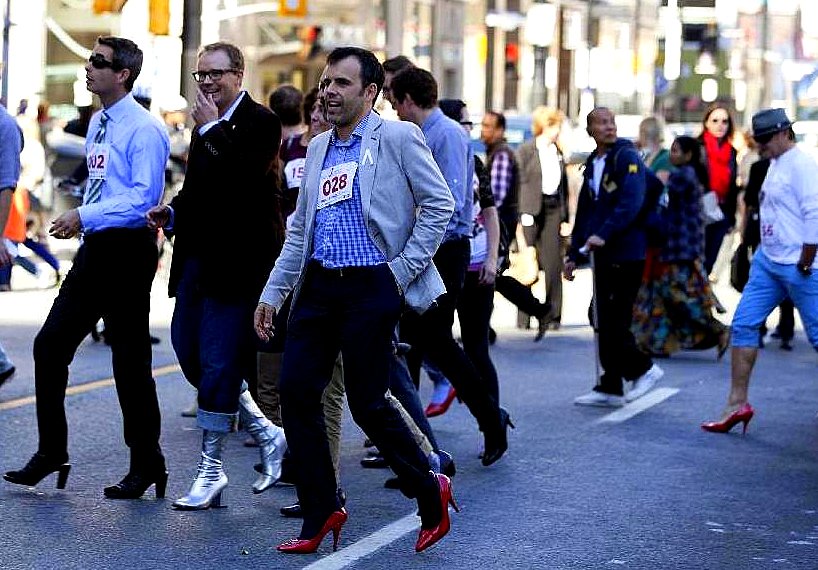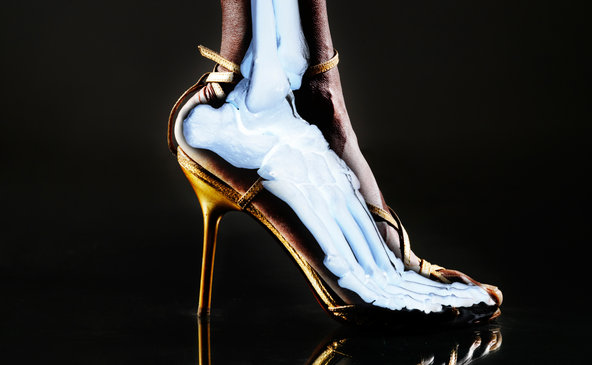You are using an out of date browser. It may not display this or other websites correctly.
You should upgrade or use an alternative browser.
You should upgrade or use an alternative browser.
اونچے سینڈل سے گھٹنے اور کمر کی تکلیف
- Thread starter barca
- Start date
Atif
Chief Minister (5k+ posts)
(bigsmile)کسی تکنیکی خرابی کی وجہ سے ، عقل ٹخنوں میں ہو تو ، پھر تو بہت نقصان دہ ،
یہ تکنیکی خرابی ہم نے ہر ماڈل میں پائی مرشد۔لہذٰا جس کا دماغ صحیح جگہ پایا وہ تفتیش کے بعد مرد نکلا۔
:(
Niazi Hawk
Minister (2k+ posts)
yaar yeh baat na kro..........mri bndi ko bri tension hoo gee agar heel na hoo tu........mera 6 ft 2 inch qad hai,,,,,,,,,,,koi aesi bachi aaj tk nhi dekhi jis ki highet 5 ft 7 inch bhi hoo...........koi sada khayal kro
tariisb
Chief Minister (5k+ posts)
یہ تکنیکی خرابی ہم نے ہر ماڈل میں پائی مرشد۔لہذٰا جس کا دماغ صحیح جگہ پایا وہ تفتیش کے بعد مرد نکلا۔:(
:lol:اور ٹھک ٹھک پر ناچنے والا ، بعد از تفتیش زنخا نکلا ،
tariisb
Chief Minister (5k+ posts)
yaar yeh baat na kro..........mri bndi ko bri tension hoo gee agar heel na hoo tu........mera 6 ft 2 inch qad hai,,,,,,,,,,,koi aesi bachi aaj tk nhi dekhi jis ki highet 5 ft 7 inch bhi hoo...........koi sada khayal kro
Size Doesn't Matter ,
پرکھنے ، جانچنے میں ، پیمانے کا کیا کام ؟ بہت سے دراز قد بہت چھوٹے نکلے ، جنھیں اونچا سمجھا ، بہت نیچ نکلے
دل چھوٹا مت کیجئیے ، سب بڑا اور بھلا ہو گا ،
(bigsmile)
barca
Prime Minister (20k+ posts)
یہ تکنیکی خرابی ہم نے ہر ماڈل میں پائی مرشد۔لہذٰا جس کا دماغ صحیح جگہ پایا وہ تفتیش کے بعد مرد نکلا۔:(
یہ والا مرد تو نہیں ؟ :lol:


Atif
Chief Minister (5k+ posts)
yaar yeh baat na kro..........mri bndi ko bri tension hoo gee agar heel na hoo tu........mera 6 ft 2 inch qad hai,,,,,,,,,,,koi aesi bachi aaj tk nhi dekhi jis ki highet 5 ft 7 inch bhi hoo...........koi sada khayal kro
نیازی بھائی! اس عفیفہ کو سمجھا دینا عورت کی بلندی کردار سے ناپی جاتی ہے سینڈل سے نہیں۔ اس ٹوٹکےسے آپکی زندگی میں سینڈل کا سامنا یا پیچھا کرنے کا خدشات بھی کم ہو جائیں گے۔
(bigsmile)
Niazi Hawk
Minister (2k+ posts)
ustad mohtram baat ap ki bilkul sahi,......laken ap ko sach bataon ky 4 saal jahan uni mein parha aksar larkean meri highet ko bry ghoor sy dekhty theen,,,,,,,,bus ab kya btaon ap ko aik larki mujhey bht aachi lgti thi laken highet shyd 5 4 bhi nhi thi,,,,aacha khasa haal dil sunany ja rha tha laken dostoon ny bary qaad ko barean bna ky poan mein daal dya,,,,,,,,,yaad e mazi azab hai ya rab............
Size Doesn't Matter ,
پرکھنے ، جانچنے میں ، پیمانے کا کیا کام ؟ بہت سے دراز قد بہت چھوٹے نکلے ، جنھیں اونچا سمجھا ، بہت نیچ نکلے
دل چھوٹا مت کیجئیے ، سب بڑا اور بھلا ہو گا ،
(bigsmile)
Niazi Hawk
Minister (2k+ posts)
bht khoob kha atif bahi aap ny,,,,,,,,,
نیازی بھائی! اس عفیفہ کو سمجھا دینا عورت کی بلندی کردار سے ناپی جاتی ہے سینڈل سے نہیں۔ اس ٹوٹکےسے آپکی زندگی میں سینڈل کا سامنا یا پیچھا کرنے کا خدشات بھی کم ہو جائیں گے۔(bigsmile)
tariisb
Chief Minister (5k+ posts)
ustad mohtram baat ap ki bilkul sahi,......laken ap ko sach bataon ky 4 saal jahan uni mein parha aksar larkean meri highet ko bry ghoor sy dekhty theen,,,,,,,,bus ab kya btaon ap ko aik larki mujhey bht aachi lgti thi laken highet shyd 5 4 bhi nhi thi,,,,aacha khasa haal dil sunany ja rha tha laken dostoon ny bary qaad ko barean bna ky poan mein daal dya,,,,,,,,,yaad e mazi azab hai ya rab............
کوئی بات نہیں ، سب کا ماضی عذاب ہے یا "نیازی" ، کوئی قد سے رہ گیا ، کوئی قدموں میں ڈھ گیا ، کسی کو "نظر" نے پچھاڑا ، کسی کو "نشیب و فراز" نے مشتعل کیا ، کوئی دو چار قدم ہی نڈھال ہوا ، کوئی بیچ سمندر میں تشنہ لب رہا ،
اک آپ ہی نہیں ، جسے دیکھو یہاں ؟ ہر رال ہے ، نم ،
(bigsmile)کامل کوئی بھی نا ملے گا ، سائیڈ افیکٹ تو سب کے ساتھ "مسٹ" ملے گا
Niazi Hawk
Minister (2k+ posts)
niazi hoo,tari hoo ya jo bhi hoo............sab hee is marhaly sy guzar chuky hain....nazar sy pichar khana,ya doo char qadamoo mein nadhal hna,yeh tu koi bri baat nhi....haan qadamoon mein dahey jna ya nasheeb o faraz sy mushtail hna.......itni tehri kheer hum sy nhi kahi jaye gee,,,,,,baqi jo beech sumandar ky tishna lab reh gya....samjh nhi a rhi us sy kesy afsos kroon.......
کوئی بات نہیں ، سب کا ماضی عذاب ہے یا "نیازی" ، کوئی قد سے رہ گیا ، کوئی قدموں میں ڈھ گیا ، کسی کو "نظر" نے پچھاڑا ، کسی کو "نشیب و فراز" نے مشتعل کیا ، کوئی دو چار قدم ہی نڈھال ہوا ، کوئی بیچ سمندر میں تشنہ لب رہا ،
اک آپ ہی نہیں ، جسے دیکھو یہاں ؟ ہر رال ہے ، نم ،
(bigsmile)کامل کوئی بھی نا ملے گا ، سائیڈ افیکٹ تو سب کے ساتھ "مسٹ" ملے گا
tariisb
Chief Minister (5k+ posts)
niazi hoo,tari hoo ya jo bhi hoo............sab hee is marhaly sy guzar chuky hain....nazar sy pichar khana,ya doo char qadamoo mein nadhal hna,yeh tu koi bri baat nhi....haan qadamoon mein dahey jna ya nasheeb o faraz sy mushtail hna.......itni tehri kheer hum sy nhi kahi jaye gee,,,,,,baqi jo beech sumandar ky tishna lab reh gya....samjh nhi a rhi us sy kesy afsos kroon.......
چلیں اب موڈ "ٹھنڈا" کر لیں ، آدھی رات کو یہ حبس ، صحت کے لیے مفید نہیں ، لوٹ آئیے ، "ہفتہ" ہنوز دور است
ٹھنڈک کے لیے ، لطیفہ ، اپ کے گھٹنوں میں ؟ اوہ معذرت کافی اوپر ہو گیا ، قدموں میں پیش ہے

ایک اور بھی آپ کی نظر

Night_Hawk
Siasat.pk - Blogger
[h=2]HIGH HEELS CAN COST YOU MORE THAN MONEY; BACK PAIN IS ONE OF MANY NEGATIVE EFFECTS[/h]

Posted by Dr. Brian Subach
August 10, 2012
The latest footwear trends as of late have been: the bigger the better! Sky high heels may make your legs look long and lean but they can be causing permanent damage. Read on to find out why you may want to limit strapping on your stilettos.
Top Six Negative Effects of Wearing High Heels:
Back:
Wearing high heels can shape your posture. The heel of your foot is unnaturally placed above your toes, which puts your entire body out of alignment. When your center of gravity is pushed forward, your lower back is strained by trying to compensate for the unnatural position. Changing position of the spine can put pressure on the nerves in your lumbar region, which can then lead to sciatica, a shooting pain, tingling or numbness down the leg and/or general aches and pain.
Knee:
High heels naturally throw your body into a forward position and can put increased pressure, up 26%, on the inside of the knee. Increased pressure can lead to degenerative joint disease or even arthritis.
Calf:
Recent studies have shown that long-term wear of high heels (two inches or higher) can minimize a woman’s calf muscle up to 13 percent, permanently. The Achilles tendon, attached to the calf muscle, can also shorten and tighten by up to 22 percent.
“Pump Bump”:
The scientific term is, Haglund’s deformity, caused by pressure on the back of the heel from shoes. Women who have a more prominent calcaneus (bump underneath the attachment of the Achilles tendon) are more likely to develop “pump bump” from shoes rubbing and irritating the heel.
Ankle:
Too high of a heel can cause imbalance in even the most seasoned stiletto wearer. Imbalance from high heels coupled with weak ankles can increase your chance of falling and/or spraining your ankle.
Foot:
Studies suggest that women should mix up their footwear during the week, switching from heels to flats. Proper fit, arch support, a low heel and stretching can lower your risk for developing any of the above. Worried about shelving your high heels? Fret not; you can still have it all, there are many stylish low heeled options on the market.

Posted by Dr. Brian Subach
August 10, 2012
The latest footwear trends as of late have been: the bigger the better! Sky high heels may make your legs look long and lean but they can be causing permanent damage. Read on to find out why you may want to limit strapping on your stilettos.
Top Six Negative Effects of Wearing High Heels:
Back:
Wearing high heels can shape your posture. The heel of your foot is unnaturally placed above your toes, which puts your entire body out of alignment. When your center of gravity is pushed forward, your lower back is strained by trying to compensate for the unnatural position. Changing position of the spine can put pressure on the nerves in your lumbar region, which can then lead to sciatica, a shooting pain, tingling or numbness down the leg and/or general aches and pain.
Knee:
High heels naturally throw your body into a forward position and can put increased pressure, up 26%, on the inside of the knee. Increased pressure can lead to degenerative joint disease or even arthritis.
Calf:
Recent studies have shown that long-term wear of high heels (two inches or higher) can minimize a woman’s calf muscle up to 13 percent, permanently. The Achilles tendon, attached to the calf muscle, can also shorten and tighten by up to 22 percent.
“Pump Bump”:
The scientific term is, Haglund’s deformity, caused by pressure on the back of the heel from shoes. Women who have a more prominent calcaneus (bump underneath the attachment of the Achilles tendon) are more likely to develop “pump bump” from shoes rubbing and irritating the heel.
Ankle:
Too high of a heel can cause imbalance in even the most seasoned stiletto wearer. Imbalance from high heels coupled with weak ankles can increase your chance of falling and/or spraining your ankle.
Foot:
- Metatarsaigia: Pain and inflammation in the ball of your foot, can be developed by wearing ill-fitting high heels.
- Hammertoes: Condition caused by improper fit, the toes curl up to fit the footwear and can become misshapen, permanently.
- Bunions: Abnormal, bony bumps that form on the joint of the big toe. The most common cause is wearing shoes that are too tight in the foot bed.
- Morton’s neuroma: A thickening of tissue around a nerve leading to your toes. This condition that commonly affects the area between your third and fourth toes. Morton’s neuroma can feel like there is a pebble in your shoe, or cause a sharp pain in the ball of your foot. The cause is typically from irritation, injury or pressure.
Studies suggest that women should mix up their footwear during the week, switching from heels to flats. Proper fit, arch support, a low heel and stretching can lower your risk for developing any of the above. Worried about shelving your high heels? Fret not; you can still have it all, there are many stylish low heeled options on the market.
Night_Hawk
Siasat.pk - Blogger
[h=1]A Scientific Look at the Dangers of High Heels[/h] By GRETCHEN REYNOLDS
 Illustration by Henrik Sorensen
Illustration by Henrik Sorensen

Not long ago, Neil J. Cronin, a postdoctoral researcher, and two of his colleagues at the Musculoskeletal Research Program at Griffith University in Queensland, Australia, were having coffee on the university’s campus when they noticed a young woman tottering past in high heels. “She looked quite uncomfortable and unstable,” Dr. Cronin says.
Some observers, particularly women, might have winced in sympathy or, alternatively, wondered where she’d bought stilettos. But the three researchers, men who study the biomechanics of walking, were struck instead by the scientific implications of her passage. “We began to consider what might be happening at the muscle and tendon level” in women who wear heels, Dr. Cronin says.

[h=6]Phys Ed[/h]Gretchen Reynolds on the science of fitness.
How shoes affect human gait is a controversial topic these days. The popularity of barefoot running, for instance, has grown in large part because of the belief, still unproven, that wearing modern, well-cushioned running shoes decreases foot strength and proprioception, the sense of how the body is positioned in space, and contributes to running-related injuries.
Whether high heels might likewise affect the wearer’s biomechanics and injury risk has received scant scientific attention, however, even though millions of women wear heels almost every day. So, in one of the first studies of its kind, the Australian scientists recruited nine young women who had worn high heels for at least 40 hours a week for a minimum of two years. The scientists also recruited 10 young women who rarely, if ever, wore heels to serve as controls. The women were in their late teens, 20s or early 30s.
The scientists asked the heel-wearing women to bring their favorite pair of high-heeled shoes to the lab. There, both groups of women were equipped with electrodes to track leg-muscle activity, as well as motion-capture reflective markers. Ultrasound probes measured the length of muscle fibers in their legs.
All of the women strode multiple times along a 26-foot-long walkway that contained a plate to gauge the forces generated as they walked. The control group covered the walkway 10 times while barefoot. The other women walked barefoot 10 times and in their chosen heels 10 times.
It was obvious, as the scientists had suspected watching the woman during their coffee break, that the women habituated to high heels walked differently from those who usually wore flats, even when the heel wearers went barefoot. But the nature and extent of the differences were surprising. In results published last week in The Journal of Applied Physiology, the scientists found that heel wearers moved with shorter, more forceful strides than the control group, their feet perpetually in a flexed, toes-pointed position. This movement pattern continued even when the women kicked off their heels and walked barefoot. As a result, the fibers in their calf muscles had shortened and they put much greater mechanical strain on their calf muscles than the control group did.
In that control group, the women who rarely wore heels, walking primarily involved stretching and stressing their tendons, especially the Achilles tendon. But in the heel wearers, the walking mostly engaged their muscles.
That biomechanical distinction is important, says Dr. Cronin, who is now a researcher at the University of Jyvaskyla in Finland. “Several studies have shown that optimal muscle-tendon efficiency” while walking “occurs when the muscle stays approximately the same length while the tendon lengthens. When the tendon lengthens, it stores elastic energy and later returns it when the foot pushes off the ground. Tendons are more effective springs than muscles,” he continues. So by stretching and straining their already shortened calf muscles, the heel wearers walk less efficiently with or without heels, he says, requiring more energy to cover the same amount of ground as people in flats and probably causing muscle fatigue.
The obvious question raised by the findings, though, is so what? Does it fundamentally matter if a woman’s calf muscle fibers shorten and she neglects her tendons while walking, especially if she loves the looks of her Louboutins?
That question is difficult for a biomechanist to answer, Dr. Cronin admits. Aesthetics are outside the realm of his branch of science. But the risk of injury is not. “We think that the large muscle strains that occur when walking in heels may ultimately increase the likelihood of strain injuries,” he says. (This risk is separate from the chances that a woman, if unfamiliar with heels, may topple sideways and twist an ankle or bruise her self-image, which is an acute injury and happened to me only the one time.)
The risks extend to workouts, when heel wearers abruptly switch to sneakers or other flat shoes. “In a person who wears heels most of her working week,” Dr. Cronin says, the foot and leg positioning in heels “becomes the new default position for the joints and the structures within. Any change to this default setting,” he says, like pulling on Keds or Crocs, constitutes “a novel environment, which could increase injury risk.”
It should be noted, he adds, that in his study, the volunteers “were quite young, average age 25, suggesting that it is not necessary to wear heels for a long time, meaning decades, before adaptations start to occur.”
So, if you do wear heels and are at all concerned about muscle and joint strains, his advice is simple. Try, if possible, to ease back a bit on the towering footwear, he says. Wear high heels maybe “once or twice a week,” he says. And if that’s not practical or desirable, “try to remove the heels whenever possible, such as when you’re sitting at your desk.” The shoes can remain alluring, even nestled beside your feet.
http://well.blogs.nytimes.com/2012/01/25/scientists-look-at-the-dangers-of-high-heels/?_r=0


Not long ago, Neil J. Cronin, a postdoctoral researcher, and two of his colleagues at the Musculoskeletal Research Program at Griffith University in Queensland, Australia, were having coffee on the university’s campus when they noticed a young woman tottering past in high heels. “She looked quite uncomfortable and unstable,” Dr. Cronin says.
Some observers, particularly women, might have winced in sympathy or, alternatively, wondered where she’d bought stilettos. But the three researchers, men who study the biomechanics of walking, were struck instead by the scientific implications of her passage. “We began to consider what might be happening at the muscle and tendon level” in women who wear heels, Dr. Cronin says.

[h=6]Phys Ed[/h]Gretchen Reynolds on the science of fitness.
How shoes affect human gait is a controversial topic these days. The popularity of barefoot running, for instance, has grown in large part because of the belief, still unproven, that wearing modern, well-cushioned running shoes decreases foot strength and proprioception, the sense of how the body is positioned in space, and contributes to running-related injuries.
Whether high heels might likewise affect the wearer’s biomechanics and injury risk has received scant scientific attention, however, even though millions of women wear heels almost every day. So, in one of the first studies of its kind, the Australian scientists recruited nine young women who had worn high heels for at least 40 hours a week for a minimum of two years. The scientists also recruited 10 young women who rarely, if ever, wore heels to serve as controls. The women were in their late teens, 20s or early 30s.
The scientists asked the heel-wearing women to bring their favorite pair of high-heeled shoes to the lab. There, both groups of women were equipped with electrodes to track leg-muscle activity, as well as motion-capture reflective markers. Ultrasound probes measured the length of muscle fibers in their legs.
All of the women strode multiple times along a 26-foot-long walkway that contained a plate to gauge the forces generated as they walked. The control group covered the walkway 10 times while barefoot. The other women walked barefoot 10 times and in their chosen heels 10 times.
It was obvious, as the scientists had suspected watching the woman during their coffee break, that the women habituated to high heels walked differently from those who usually wore flats, even when the heel wearers went barefoot. But the nature and extent of the differences were surprising. In results published last week in The Journal of Applied Physiology, the scientists found that heel wearers moved with shorter, more forceful strides than the control group, their feet perpetually in a flexed, toes-pointed position. This movement pattern continued even when the women kicked off their heels and walked barefoot. As a result, the fibers in their calf muscles had shortened and they put much greater mechanical strain on their calf muscles than the control group did.
In that control group, the women who rarely wore heels, walking primarily involved stretching and stressing their tendons, especially the Achilles tendon. But in the heel wearers, the walking mostly engaged their muscles.
That biomechanical distinction is important, says Dr. Cronin, who is now a researcher at the University of Jyvaskyla in Finland. “Several studies have shown that optimal muscle-tendon efficiency” while walking “occurs when the muscle stays approximately the same length while the tendon lengthens. When the tendon lengthens, it stores elastic energy and later returns it when the foot pushes off the ground. Tendons are more effective springs than muscles,” he continues. So by stretching and straining their already shortened calf muscles, the heel wearers walk less efficiently with or without heels, he says, requiring more energy to cover the same amount of ground as people in flats and probably causing muscle fatigue.
The obvious question raised by the findings, though, is so what? Does it fundamentally matter if a woman’s calf muscle fibers shorten and she neglects her tendons while walking, especially if she loves the looks of her Louboutins?
That question is difficult for a biomechanist to answer, Dr. Cronin admits. Aesthetics are outside the realm of his branch of science. But the risk of injury is not. “We think that the large muscle strains that occur when walking in heels may ultimately increase the likelihood of strain injuries,” he says. (This risk is separate from the chances that a woman, if unfamiliar with heels, may topple sideways and twist an ankle or bruise her self-image, which is an acute injury and happened to me only the one time.)
The risks extend to workouts, when heel wearers abruptly switch to sneakers or other flat shoes. “In a person who wears heels most of her working week,” Dr. Cronin says, the foot and leg positioning in heels “becomes the new default position for the joints and the structures within. Any change to this default setting,” he says, like pulling on Keds or Crocs, constitutes “a novel environment, which could increase injury risk.”
It should be noted, he adds, that in his study, the volunteers “were quite young, average age 25, suggesting that it is not necessary to wear heels for a long time, meaning decades, before adaptations start to occur.”
So, if you do wear heels and are at all concerned about muscle and joint strains, his advice is simple. Try, if possible, to ease back a bit on the towering footwear, he says. Wear high heels maybe “once or twice a week,” he says. And if that’s not practical or desirable, “try to remove the heels whenever possible, such as when you’re sitting at your desk.” The shoes can remain alluring, even nestled beside your feet.
http://well.blogs.nytimes.com/2012/01/25/scientists-look-at-the-dangers-of-high-heels/?_r=0
IhsanIlahi
Chief Minister (5k+ posts)
Heel heel ho rahi hai yaha pe.... wo heel wali kidhar hai...
jerry719964
Senator (1k+ posts)
مجھے تو ایسا لگ رہا ہے جیسے میں نے سیاست پی کے کی بجائے کسی مارننگ شو کی ویب سائٹ کھول لی جس میں زبیدہ آپا عرف بارسا عورتوں کو نئے ٹوٹکے بتا رہی ہیں
© Copyrights 2008 - 2025 Siasat.pk - All Rights Reserved. Privacy Policy | Disclaimer|



































